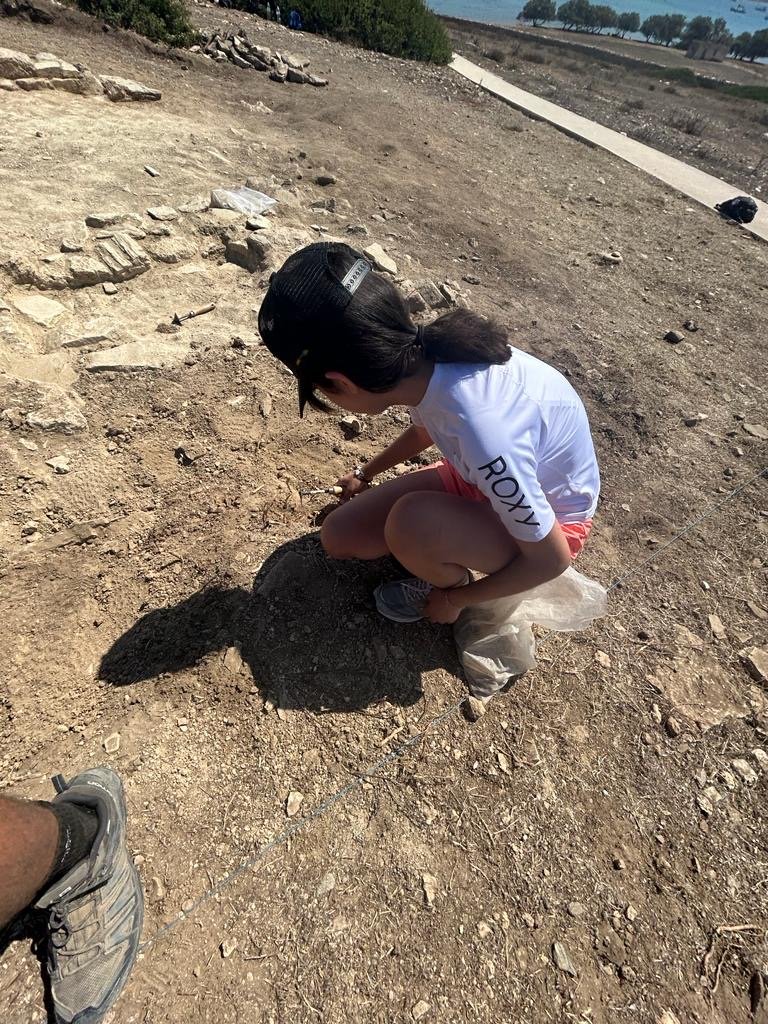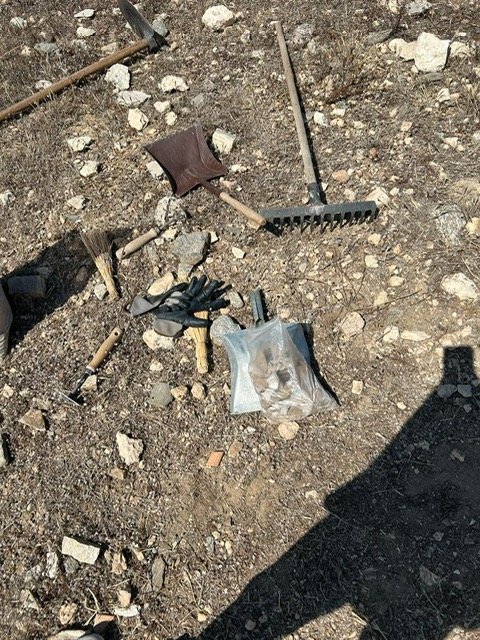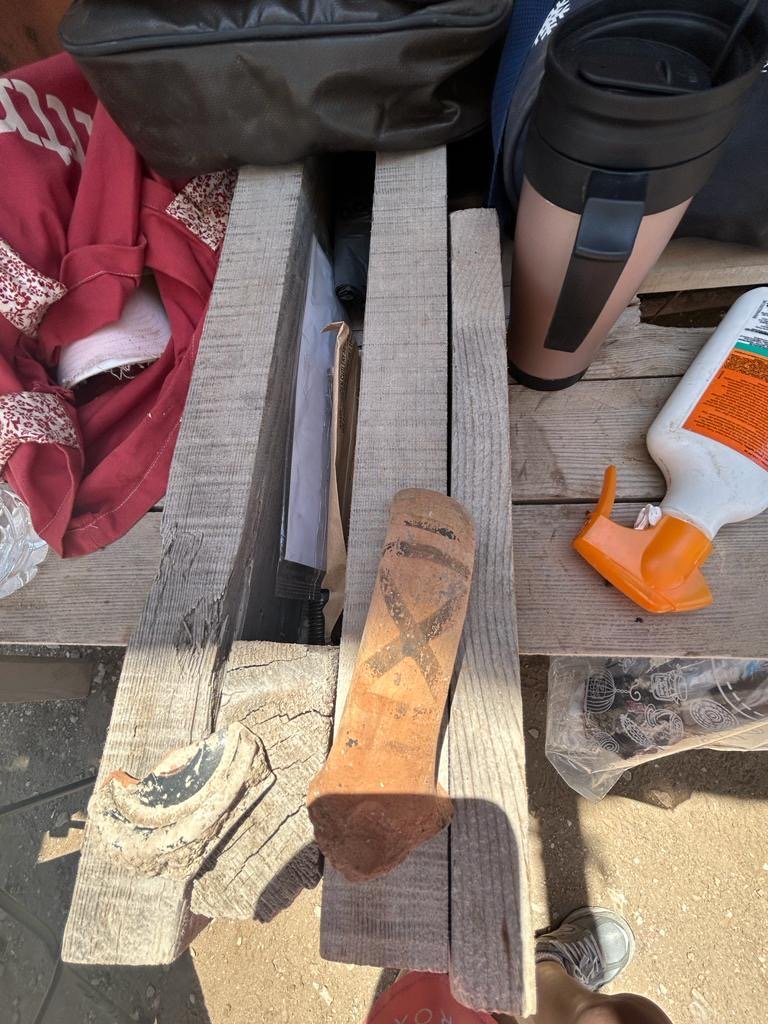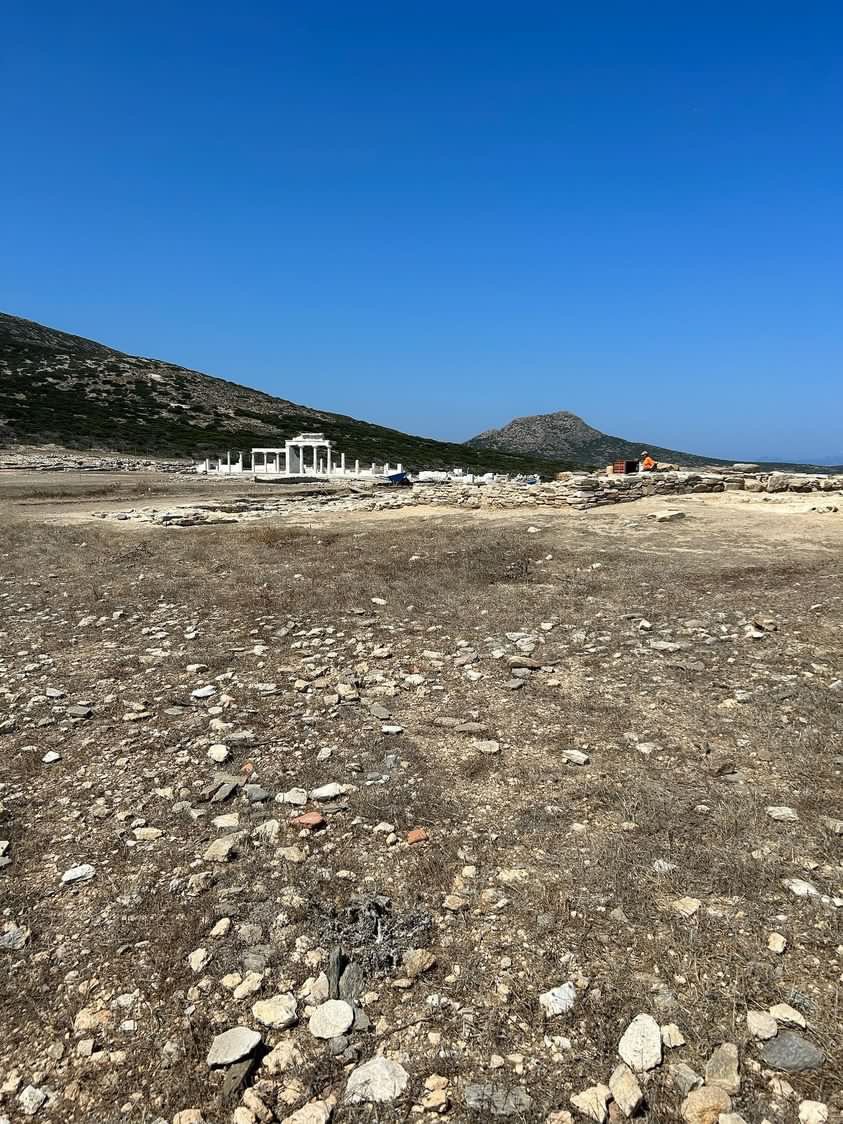Despotiko, Greece
Excavating archaeological sites is our best bet to time travel, I think.
Few statements depict the thrill of discovery as Henirich Schliemann’s “I have gazed on the face of Agamemnon” upon discovering the burial mask of the Mycenaean king. Schliemann is revered for his 1871-1873 excavation of Troy and the 1876 excavation of Mycenae. Ever wondered how it would feel to unearth, touch and explore artifacts buried for thousands of years? Are you, like me, one of the people that yearns to be able to analyze up close the shapes and designs of an ancient piece of pottery? Or the intricate details of a marble statue’s hair? And while surrounded by the newly unearthed broken statues, pillars and everyday pottery, imagine what an archaeological site looked like when everyday people would walk it to worship their gods, go for a walk along the shore or conduct everyday business? I always marveled at the insights we can gain from ancient artifacts to how people lived, worked, dreamt. Through excavations, we discover ancient trade routes we did not know existed by the mere presence of a Phoenician vase on a Greek island shore; or who was ostracized, i.e., exiled, from ancient Athens by reading his name on the back of a shell (ostraco, in Greek) found buried thousands of years later. And more importantly, we can derive insights on what makes people fight civil wars, go on conquests to faraway lands, or how they dealt with political upheaval and natural disasters. What are the lessons we can learn? And maybe, just maybe, how do we predict and prevent history repeating itself by recognizing the signs for which our ancestors did not have the benefit of hindsight?
I have been lucky and incredibly honored to be one of two high schoolers invited to join a team of archaeologists and graduate students in the excavation of the archaic sanctuary of Apollo on the island of Despotiko in Greece. I owe a special thanks to the College Year in Athens foundation and its chair of the board, Alexis Phylactopoulos, as well as the Greek Ministry of Culture and archaeologist Yannos Kourayos, Director of Excavation at Despotiko, for letting me be part of the Despotiko excavation team in the summer of 2023. My observations, thoughts, feelings and insights below are derived from my time there.
The majority of the pictures shown have been taken by me with kind permission from the Excavation Team. The timeline information of the site was informed by the “Despotiko; a journey in time” book, by Yannos Kourayos and the Municipality of Antiparos, 2018.
At the center of the Cyclades.
Situated at the center of the Aegean Sea as part of the Cyclades island group, Despotiko is just west of the island of Paros, one of the most famous city states of Ancient Greece’s golden age. Very much like Delos, a more well known Apollo sanctuary just off the coast of the island of Myconos, there is evidence that Despotiko was an equally or even more important sanctuary for the Sun god in the Archaic period. Connected to the island of Antiparos via an isthmus in antiquity, it is now an island with a lot of its ancient ruins lying at the bottom of the shallow waters that have completely flooded the ancient isthmus.
A magnificent place.
Why did certain civilizations develop in certain regions versus others? Was it due to the weather being conducive to an easier life, access to the water for maritime trade, the presence of domesticated animals that made transport possible, the availability of natural resources? A combination or all of the above? Watching this video, one can easily infer that Despotiko had all of the above. The mild mediterranean climate, its location at the center of trade routes and the prosperous city states around it made it an ideal location for worshipping one of Ancient Greece’s most beloved gods, Apollo, the Sun god.
Timeline.
The earliest habitation traces on Despotiko date back to the Early Cycladic period (3rd millennium BCE). The next habitation phase dates back to the Geometric period (9th century BCE). While there have been a number of edifices unburied since excavation at Despotiko started in 2001, the team is still finding more buildings closer to the shore. The largest edifice so far is the oval building of the 8th century BCE, which represents the earliest construction of the site up to date. The remains of the building have guided the reconstruction of the rest of what once stood there. The marble used was the world famous Parian marble from nearby Paros island. This building alone reveals many of the sanctuary’s secrets. Within its walls we continue to find worship offerings of different materials and types extending from the Early Iron Age (9th-8th century BCE) to the Classical period (5th-4th century BCE). The building was dedicated to Apollo and operated until the Hellenistic period (2nd century BCE). Over the Roman period (2nd century BCE to 4th century CE) the sanctuary gradually stopped functioning and the buildings were used for residential purposes up until the 17th century CE. Over the last two centuries the island has been uninhabited and only used by shepherds who established animal pens. Over 23 years of excavation, the revelation of the Apollo sanctuary, adjacent buildings, an ancient port, myriad artifacts, statues and a sophisticated plumbing system, have rendered the Despotiko sanctuary as an enormously significant archaeological site. The vision of the archaeological team is to finish the excavation and restoration work and transform Despotiko into an experiential archaeological park.
Morning routine.
The archaeological site of Despotiko is closed off to the public while the excavations and restorations of key edifices is ongoing. We were the fortunate few boarding a fishing boat every morning at 7:00am, to avoid the scorching sun, from the port of Agios Georgios on Antiparos to bring us to the opposite shore; a roughly 10 minute boat ride. Our team consisted of 4 archaeologists from the Ministry of Culture and the University of Ioannina, a group of 10 American graduate students in Classics from colleges like Princeton, Cornell, etc., a Greek high schooler and me.
Work would start immediately and the same boat would bring us back around 2:30pm, well into the hottest time of day. The archaeological site offered few shady places; the most coveted one being the small hut that had the sink to wash the dirt off the unearthed artifacts. I immediately volunteered for the washing task which I found extremely fulfilling as I marveled at the shapes and colors of the vase fragments that revealed themselves to me. But very soon I realized that all the excitement happened in the digging task. The screams of joy as the team would uncover a new finding in the dirt soon had me out of the kitchen digging…
Here I am using the triangle to carefully unearth a piece of pottery
The tools.
The very modest excavation tools dating back centuries remain highly effective. We used trowels and brushes to gently dig and scrape dirt off stone walls and the earth below our feet. But the most underrated tool was the triangle; also known as triangular scraper. It is a wonderful simple iron triangle mounted on a wooden handle. It works wonders in revealing buried objects and gently scraping them out of walls or the floor.
There are so many broken fragments everywhere, you can hear them crack like sea shells under the weight of our feet. We learn to look for the precious ones - the ones with patterns, colors or even better letters - the rest we leave alone or collect in a big bucket for disposal. Every time I found a patterned, large vase or pot fragment, I let out a cry of excitement, washed it, cataloged it and sealed it for transfer to the Archaeological Museum of Paros - the joy of the end to end excavation process.
The methods.
I could not be more proud of the artifacts I unearthed myself in the pictures here. The ones with patterns or designs are the most valuable. Once you undig one you need to sift through the nearby dirt to make sure there are no matching fragments to complete the puzzle. Any nearby objects also provide context on the rest of the findings in that vicinity. Excavations happen in layers. These are indicative of the age of the artifacts found as each geographical layer corresponds to a specific era. And as you excavate you always indicate in which layer every artifact was found. This enables correlations to be drawn among objects found in the same layer. This is what enables historians to draw conclusions of the timeline of certain events. The presence of Corinthian votives, for example, indicate that visitors from Corinth reached this island, which roughly sets the date of these offerings to the time of the Corinthian rise in Ancient Greece. Same story with Persian votives and Persian names inscribed on tiles and ceramics. Hence, the relative higher significance of pottery fragments that include patterns or scripts that gives us clues on the society and affairs of the time.
Items in the same layer and vicinity need to be cataloged together. Which leads me to the method of cataloging. You notice in the pictures I took how I brushed the dirt of the pottery, grouped it together in a blue bucket and they laid them on a wooden frame for measurement, labeling and cataloging. Each artifact label consists of the object name, description, measurements, the section and layer of the site that it was found. Then all this data is keyed in the database, with an indication of it relevant importance - after consultation with the on-site archaeologist - so it can decided if it should be shipped to the Archaeological Museum of Paros versus the one in Athens.
The statues.
Nothing captures the imagination more than the unearthing of a statue. I was fortunate enough to witness the exhilaration when a part of a statue was uncovered by our archaeologists during my internship. Vessels, figurines, jewelry, weapons and tools are all amazing finds, but these marble statues give a face and shape to the people of antiquity. More than 70 body parts and 9 heads of archaic sculptures have been found in the Despotiko site, most of them given as offerings to Apollo. Both the number and the quality of the sculptures indicate the wealth and importance of this sanctuary.
However, many of them were destroyed and incorporated in the walls of auxiliary buildings. This is indicative of some sort of destruction speculated to be the 490 BCE Athenian invasion of the nearby Paros island in retaliation for the Parians’ siding with the Persians during the Persian Wars. How amazing is it that we get to derive this insight from the broken statues we find within the walls.
The Lady of Despotiko, a clay female figurine, the so-called Pipina.
The 'Lady of Despotiko' is the earliest known object from the sanctuary, confirming the site’s religious function as early as the 7th century. Only her head remains, and that was put together from many fragments found scattered on site, but the archaeologists feel confident that the drawing accurately depicts the rest of the body. There is speculation that she may have been used as a pillar supporting a larger structure based on the flat frame on top of her head.
Whether Pipina was a representation of a mortal or a divine being, a religious icon or a ritual utensil, she stands as a testament to the creativity and craftsmanship of the time. (courtesy Yannos Kourayos)
Life lessons.
My summer internship on the Despotiko island, working alongside distinguished Greek archaeologists and graduate students in classics from the US, taught me so many things.
First and foremost, that people across nations who admire the birthplace of the Western civilization can work and collaborate with amazing effectiveness. The team spirit on site was unparalleled. And while we were all hard at work, there were also moments of levity and true friendship.
Working in 100 degree temperatures with little to no shade also taught me the value of perseverance and dedication. While dreading it at first, I soon found out that passion equipped with many water bottles and a hat can win over exhaustion.
And lastly, I felt extremely privileged to be the one giving artifacts a second chance in the sun after being buried for centuries; allowing them to tell us their story and reveal their secrets. I saw with my own eyes how objects carry messages from millenniums ago that can be applied to the way we work and create together.
One day on the excavation site, it occurred to me that I was working in a cemetery of sorts: a cemetery of edifices, broken statues, and vase fragments, where people long dead lived full lives, hopefully full of joy, but also marred by disease, and warfare, a combination of happy and sad days. And while we still fight pandemics and wars in our days - and have, unfortunately, become more efficient on both counts - we do make advancements in our understanding of how our universe, our planet and our society work. The fact that the traces of the Despotiko civilization that I, myself looked for on this small island, outlived its inhabitants and worshippers to inform the western civilization, would have given them a sense of great satisfaction if they could only time travel to the future. And this fleeting thought reminded me of Greek Nobel laureate George Seferis’ verses in the Mythistorema poem:
We who set out on this pilgrimage,
looked at the broken statues,
became distracted, and said that life is not so easily lost
that death has unexplored paths,
and its own particular justice;
that while we, still upright on our feet, are dying,
affiliated in stone
united in hardness and weakness
the ancient dead have escaped the circle and risen again
and smile in a strange silence.
“Mythistorema” by George Seferis, 1935















